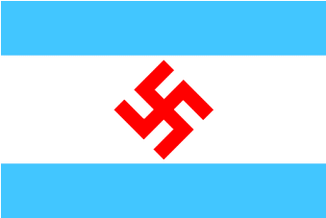
This page is part of © FOTW Flags Of The World website
Oirot Republic (1917-1922)
Last modified: 2021-08-26 by valentin poposki
Keywords: oirot republic | swastika |
Links: FOTW homepage |
search |
disclaimer and copyright |
write us |
mirrors
Ойротская Республика
See also:- Altai Republic
 Roberto Breschi, 9 Jan 2010
Roberto Breschi, 9 Jan 2010
In 1918, the educated Altaians began to use the ethnonym "Oirot" to underline their glorious origins. The Oirot ideology was eloquently articulated by V.I.Anuchin at the various meetings leading to the Congress of Altai People in Ulale. His nationalistic idea was to create an independent Greater Oirot Republic uniting the inhabitants of both, Russian and Mongolian Altai, Uriankhai (Tuva) and the Chinese Dzungaria as one tribe - the great Oirot Nation - the "Kizhi", rediscovering its historical roots, and confirming its right to the political self-determination. Proclaiming the Oirat Republic, the Congress of Ulale formed a nucleus of the Greater Oirat Republic on the territory of the Upper Altai District with the hope it would be soon encompassing the other people of the area, that it would mobilize all the Altaic people to fight for their independent statehood.
The first flag of the Oirot Republic was white, framed in blue along
all the edges - the national colors of Altai.
The state had a difficult time to function as the area was occupied by
the "White" forces of Admiral Kolchak,
who didn't look favorably at any attempts of separatism from "Mother" Russia.
Chrystian Kretowicz, 9 Jan 2010
1922 flag
 Roberto Breschi, 9 Jan 2010
Roberto Breschi, 9 Jan 2010
When the Bolsheviks prevailed in the Altai region, there was a second try to establish the Oirot Republic. In 1921, at Biysk, the republic was proclaimed again, and the tri-band of blue, white, and blue, with the red swastika in the center, was hoisted. The white band was wider than the blue ones and the swastika is a solar symbol commonly used by many nations in that part of Asia. It wasn't a successful attempt at independence, but at the regional Soviet meeting at Tomsk, on July8, 1921, the re-establisment of the Oirot Republic was, at least, discussed. The meeting was attended by some leaders of the Oirot nationalism - Anichin and Konzychakov.
They tried to resurrect the idea of the "Oirot State" tn the Soviet conditions, but the final decision was in the hands of Moscow. Konzychakov, who was a member of the Communist Party and had some influence on the decision, postulated on September 5, 1921 to the Soviet of the People's Commissars the need to combine the Altai, Biysk, Kuznetsk, Minusinsk and Achinsk counties (rayons) in the eventual Oirot Republic. The draft of the statehood, presented in Moscow, included the territory populated by the Altais, Khakass, Kumandins, Teleuts, Telangits, Tatars and some Kalmyks, all related ethnically. The nationalists efforts on the attainment of the statehood have fallen short of the expectations when the Soviet government decided finally on the formation of the national territorial units. On June 1, 1922, the Oirot Autonomous Oblast' was proclaimed, renamed as the Gorno-Altaisk Autonomous Oblast' on January 7, 1948.
On October 25, 1990 it was upgraded to the status of the Gorno-Altaisk Autonomous Soviet Socialist Republic within the Russian Socialist Federated Soviet Republic. On July 3, 1991 it became the Gorno-Altaisk Soviet Socialist Republic within Russia, changing its name again in May, 1992 to the Republic of Gorno Altai, and finally, it become on December 12, 1993 what it is today - - Altai Republic.
Roberto Breschi quotes as his sources:- Vexilología, 88, 1993 - EMBL. et Pavillons, 38, 1993
- Le Cabinet des Drapeaux, 1993 and 5, 1996
- Gaceta de Banderas, 43, 1998
- Flag Report, 15, 2000
April 1917 - May 1919 flags were not used. Janis Lasmanis states, "Unlikely flag, according to N.I. Naumova. Problems of identification of Indigenous peoples of Siberia during years of Civil War with example of Buryats (Tomsk, 2015), on Apr 1917. Buryats adopted as seal "Khiy-Morin" (horseman), but on Dec 1917 replaced it by "Khas-Tamga" (swastika), and also flag was adopted. No further details available. The swastika was also used on Buryat military uniforms.
I suppose that Swastika (WWII style) flag you had for Karakorum
is fake (Pavillons, Gaceta and Report of 1990s [sources of R.
Breschi] are not to be trusted without double-checking). In some Russian
sources (all of them referring to Russian writer/historian Volfgang Akunov,
well known for not referring to his sources) the Buryat military flag is
described as plain red with black Swastika (Asian square style, as seen on
1st Tuva flag). In some cases, this was called flag of "Red" Buryats, in some
cases (more often) of "White" Buryats. According to
http://www.kolchakiya.ru/uniformology/buryats_brigade.htm, the main color of
"White" Buryat uniform was yellow (with silver Swastika). My guess is that
the Buryat flag could be plain a with Swastika (Asian), but I'm not sure about
colors. In some serious study of Buryats it was written that Buryats during
the Civil War had no flag of their own. This also might be true, since flags of small
Altay people and, e.g. Bashkirs, are described in many trustworthy sources,
but there is almost nothing about Buryat flag (this leads to the conclusion
that V. Akunov wrote fiction). Notably, http://www.kolchakiya.ru is silent on
Buryat military flags. For now, I can suggest adding non-Buryat flags that
could be really flown in Verkhneudinsk."
Janis Lasmanis / Ben Cahoon,
20 January 2019
or.jpg)